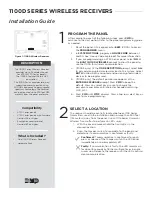
1100D SERIES WIRELESS RECEIVERS
Installation Guide
DESCRIPTION
R
Y
G
B
TO PANEL
The 1100D Series Wireless Receiver
provides up to 32 wireless zones
for XT30/XT50 Series panels.
The 1100DE features 128‑bit AES
encryption.
The 1100D Series provides two‑way,
supervised communication using
900 MHz frequency hopping spread
spectrum technology. The receiver
can be mounted up to 500 feet (152
meters) from the panel enclosure.
Compatibility
•
XT30 Series panels
•
XT50 Series panels with firmware
Version 102 or higher
•
Encryption requires panel
Version 183 or higher
What is Included?
•
One 1100D Wireless Receiver
•
Hardware Pack
1
PROGRAM THE PANEL
After completing each of the following steps, press
CMD
to
advance to the next option. Refer to the panel programming guide
as needed.
1. Reset the panel. At a keypad, enter
6653
(PROG) to access
the
PROGRAMMER
menu.
2. In
SYSTEM OPTIONS
, program a
HOUSE CODE
between 1
and 50. See “House Code Explained”
for more information.
3. If you are programming an XT50 Series panel, select
NO
at
the
BUILT IN 1100 WIRELESS
prompt to allow the panel to
use the 1100D for wireless communication.
4. (1100DE only) At the
1100 ENCRYPTION
prompt, select
ALL
to only add encrypted wireless devices to the system. Select
BOTH
to allow both encrypted and non‑encrypted wireless
devices to be programmed.
5. (1100DE only) The default passphrase appears at the
ENTER PASSPHRASE
prompt. Press
CMD
to keep the
default. Press any select key or area to change the
passphrase and enter an 8‑character hexadecimal string
(0‑9, A‑F).
6. Press
CMD
until
STOP
displays. Press a top row select key or
area to save programming.
SELECT A LOCATION
2
The receiver should be centrally located between 1100 Series
transmitters used in the installation and no more than 500 feet
(152 meters) away from the panel. Use an 1106 Series Universal
Wireless Transmitter to perform an LED survey.
1. With the cover removed, hold the transmitter in the
desired location.
2. Press the tamper switch to send data to the panel and
determine if communication is confirmed or faulty.
Confirmed:
If communication is confirmed, for each
press or release of the tamper switch, the LED blinks
immediately on and immediately off.
Faulty:
If communication is faulty, the LED remains on
for about 8 seconds or flashes multiple times in quick
succession. Relocate the receiver until the LED confirms
clear communication.
Figure 1: 1100D Wireless Receiver






















